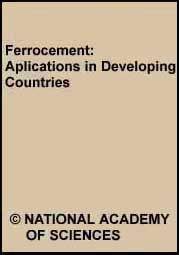
Ferrocement for Food-Processing Equipment[edit | edit source]
During the panel's deliberations on food-storage facilities, the more inclusive category of food-processing equipment as a whole emerged as an exciting possibility for ferrocement application. New to the panelists, the idea has not, to their knowledge, been studied at all in developing countries-and only slightly studied elsewhere. Though data are lacking, the subject is included in this report because the panel considers it a potentially profitable area for research.
The world food problem is caused in part by poor distribution and protection of available foodstuffs in developing countries. Most foods, especially in a raw, unprocessed state, are highly perishable; they are irreversibly affected by temperature changes and, especially, by even trace amounts of biological and chemical contaminants. All these problems are most severe in tropical climates. So, in developing countries much of the food yield deteriorates soon after harvesting because processing plants to preserve food are lacking in rural areas. Excessive costs, the absence of a suitable construction material, and lack of skilled labor prohibit the manufacture of even simple, conventional processing equipment designed to store, convey, and process bulk quantities of complex natural raw materials and their derivatives.
That most food-processing equipment is large, heavy, and awkwardly shaped constrains regions where transportation is difficult and expensive. The general lack of foreign currency in developing countries makes it difficult to pay for this equipment, which is made of steel, copper, and other metals often available only from industrialized countries.
The use of ferrocement, even on a modest scale, could influence the creation or expansion of food industries in developing countries and contribute to the improved nutrition of the inhabitants. Where transportation is difficult, ferrocement equipment can be manufactured and erected on site, by local labor, and with easily transported ingredients. It requires little foreign currency, and is uniquely suited to the fabrication of large, heavy, awkwardly shaped shell structures. It can be as strong and structurally rigid as the structures it imitates.
Extensive preliminary laboratory research is needed, particularly into the interface between a ferrocement surface and the foodstuffs it touches. This surface must be made extremely smooth, dense, and hard (for example, by techniques of multiple trowelling during the setting period). The use of coatings should be explored, such as stainless-steel foil bonded to the surface.
In addition, research must answer these questions:
- What is ferrocement's ability to meet local sanitary requirements? What methods can be used for cleaning and sterilizing?
- What are its pressure and thermal tolerances (heat transfer, thermal expansion)?
- What is the moisture-vapor transmission rate (particularly important for low-temperature applications)?
Nevertheless, a serious, large-scale effort is justifed to investigate the use of ferrocement to replace steel for the manufacture of at least some basic food-processing equipment, e.g., tanks (see Figure 12), vats, pipes, trays, drying tables, cold stores and freezing chambers,* ovens, waste-product sewage treatment facilities, butchering facilities,* and dairies.